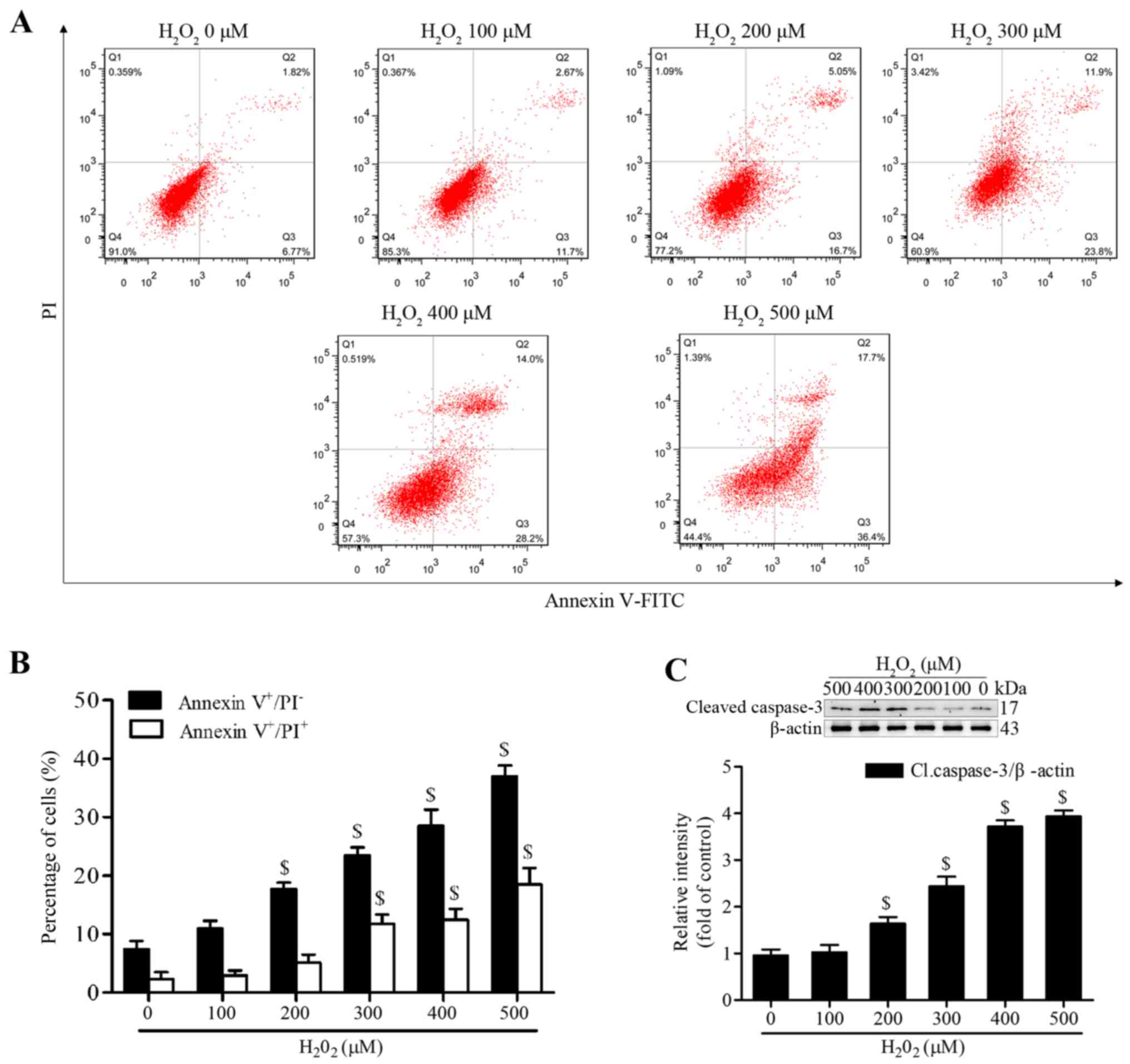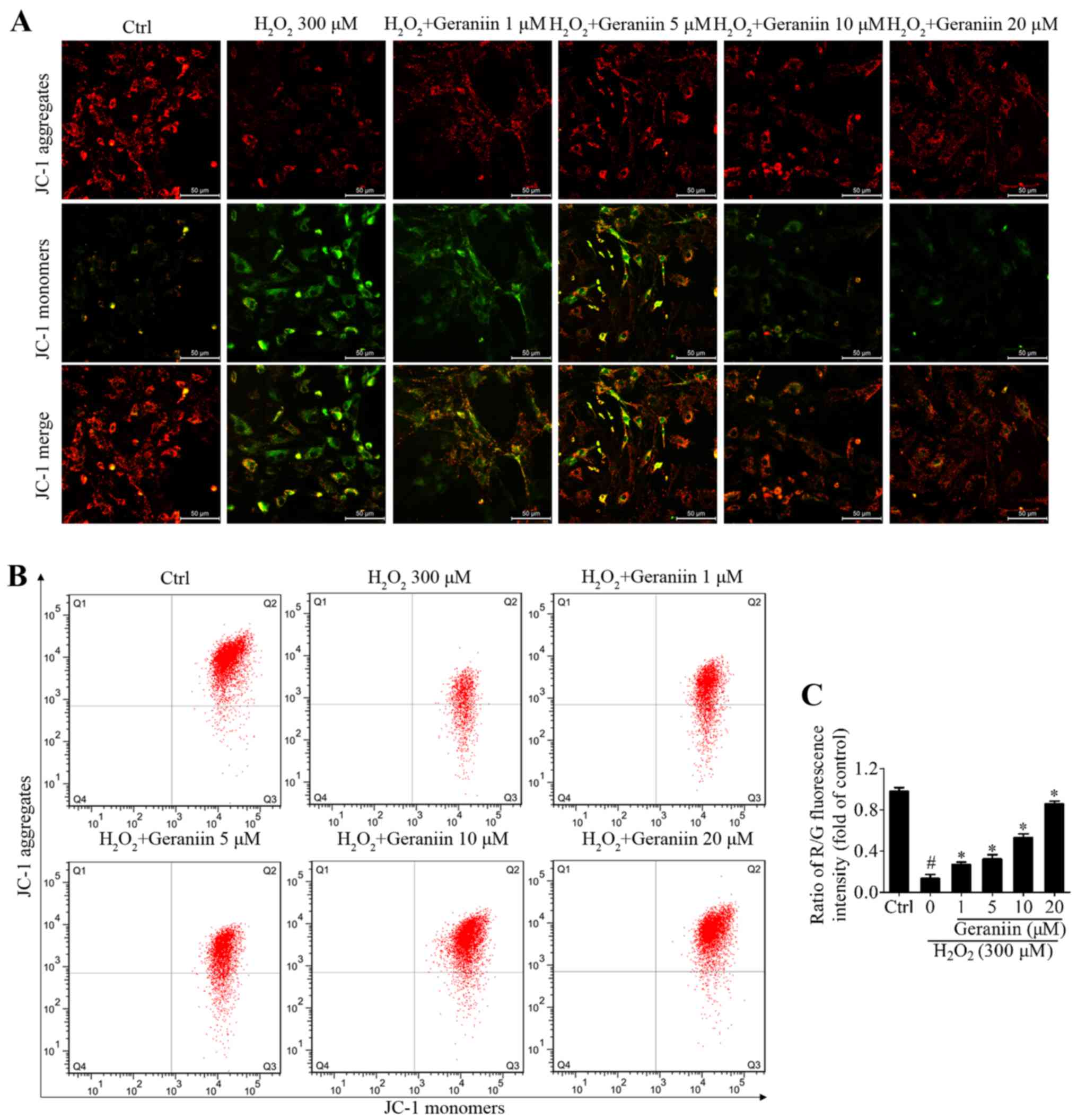|
1
|
Murray CJ, Vos T, Lozano R, Naghavi M,
Flaxman AD, Michaud C, Ezzati M, Shibuya K, Salomon JA, Abdalla S,
et al: Disability-adjusted life years (DALYs) for 291 diseases and
injuries in 21 regions, 1990–2010: A systematic analysis for the
Global Burden of Disease Study 2010. Lancet. 380:2197–2223. 2012.
View Article : Google Scholar : PubMed/NCBI
|
|
2
|
Ripa RS, Haack-Sørensen M, Wang Y,
Jørgensen E, Mortensen S, Bindslev L, Friis T and Kastrup J: Bone
marrow derived mesenchymal cell mobilization by granulocyte-colony
stimulating factor after acute myocardial infarction: Results from
the Stem Cells in Myocardial Infarction (STEMMI) trial. Circulatio.
116(Suppl 11): I24–I30. 2007. View Article : Google Scholar
|
|
3
|
Zhang Z, Liang D, Gao X, Zhao C, Qin X, Xu
Y, Su T, Sun D, Li W, Wang H, et al: Selective inhibition of
inositol hexakisphosphate kinases (IP6Ks) enhances mesenchymal stem
cell engraftment and improves therapeutic efficacy for myocardial
infarction. Basic Res Cardiol. 109:4172014. View Article : Google Scholar : PubMed/NCBI
|
|
4
|
Karantalis V and Hare JM: Use of
mesenchymal stem cells for therapy of cardiac disease. Circ Res.
116:1413–1430. 2015. View Article : Google Scholar : PubMed/NCBI
|
|
5
|
Fisher SA, Zhang H, Doree C, Mathur A and
Martin-Rendon E: Stem cell treatment for acute myocardial
infarction. Cochrane Database Syst Rev. 9:CD0065362015.
|
|
6
|
Geng YJ: Molecular mechanisms for
cardiovascular stem cell apoptosis and growth in the hearts with
atherosclerotic coronary disease and ischemic heart failure. Ann NY
Acad Sci. 1010:687–697. 2003. View Article : Google Scholar
|
|
7
|
Frangogiannis NG, Smith CW and Entman ML:
The inflammatory response in myocardial infarction. Cardiovasc Res.
53:31–47. 2002. View Article : Google Scholar
|
|
8
|
Logue SE, Gustafsson AB, Samali A and
Gottlieb RA: Ischemia/ reperfusion injury at the intersection with
cell death. J Mol Cell Cardiol. 38:21–33. 2005. View Article : Google Scholar
|
|
9
|
Quideau S, Deffieux D, Douat-Casassus C
and Pouységu L: Plant polyphenols: Chemical properties, biological
activities, and synthesis. Angew Chem Int Ed Engl. 50:586–621.
2011. View Article : Google Scholar : PubMed/NCBI
|
|
10
|
Kang NJ, Shin SH, Lee HJ and Lee KW:
Polyphenols as small molecular inhibitors of signaling cascades in
carcinogenesis. Pharmacol Ther. 130:310–324. 2011. View Article : Google Scholar : PubMed/NCBI
|
|
11
|
Marín L, Miguélez EM, Villar CJ and Lombó
F: Bioavailability of dietary polyphenols and gut microbiota
metabolism: Antimicrobial properties. BioMed Res Int. 905215:2015.
View Article : Google Scholar
|
|
12
|
Habtemariam S and Varghese GK: The
antidiabetic therapeutic potential of dietary polyphenols. Curr
Pharm Biotechnol. 15:391–400. 2014. View Article : Google Scholar : PubMed/NCBI
|
|
13
|
Collins AR: Assays for oxidative stress
and antioxidant status: Applications to research into the
biological effectiveness of polyphenols. Am J Clin Nut. 81(Suppl
1): 261S–267S. 2005.
|
|
14
|
Wu N, Zu Y, Fu Y, Kong Y, Zhao J, Li X, Li
J, Wink M and Efferth T: Antioxidant activities and xanthine
oxidase inhibitory effects of extracts and main polyphenolic
compounds obtained from Geranium sibiricum L. J Agric Food Chem.
58:4737–4743. 2010. View Article : Google Scholar : PubMed/NCBI
|
|
15
|
Londhe JS, Devasagayam TP, Foo LY, Shastry
P and Ghaskadbi SS: Geraniin and amariin, ellagitannins from
Phyllanthus amarus, protect liver cells against ethanol induced
cytotoxicity. Fitoterapia. 83:1562–1568. 2012. View Article : Google Scholar : PubMed/NCBI
|
|
16
|
Kang KA, Lee IK, Zhang R, Piao MJ, Kim KC,
Kim SY, Shin T, Kim BJ, Lee NH and Hyun JW: Radioprotective effect
of geraniin via the inhibition of apoptosis triggered by
γ-radiation-induced oxidative stress. Cell Biol Toxicol. 27:83–94.
2011. View Article : Google Scholar
|
|
17
|
Liu X, Li J, Peng X, Lv B, Wang P, Zhao X
and Yu B: Geraniin inhibits LPS-induced THP-1 macrophages switching
to M1 phenotype via SOCS1/NF-κB pathway. Inflammation.
39:1421–1433. 2016. View Article : Google Scholar : PubMed/NCBI
|
|
18
|
Zhang F, Cui J, Lv B and Yu B: Nicorandil
protects mesenchymal stem cells against hypoxia and serum
deprivation-induced apoptosis. Int J Mol Med. 36:415–423. 2015.
View Article : Google Scholar : PubMed/NCBI
|
|
19
|
Zhang LL, Liu JJ, Liu F, Liu WH, Wang YS,
Zhu B and Yu B: MiR-499 induces cardiac differentiation of rat
mesenchymal stem cells through wnt/β-catenin signaling pathway.
Biochem Biophys Res Commun. 420:875–881. 2012. View Article : Google Scholar : PubMed/NCBI
|
|
20
|
Wang XY, Fan XS, Cai L, Liu S, Cong XF and
Chen X: Lysophosphatidic acid rescues bone mesenchymal stem cells
from hydrogen peroxide-induced apoptosis. Apoptosis. 20:273–284.
2015. View Article : Google Scholar : PubMed/NCBI
|
|
21
|
Zhou H, Li D, Shi C, Xin T, Yang J, Zhou
Y, Hu S, Tian F, Wang J and Chen Y: Effects of exendin-4 on bone
marrow mesenchymal stem cell proliferation, migration and apoptosis
in vitro. Sci Rep. 5:128982015. View Article : Google Scholar : PubMed/NCBI
|
|
22
|
Maryanovich M and Gross A: A ROS rheostat
for cell fate regulation. Trends Cell Biol. 23:129–134. 2013.
View Article : Google Scholar
|
|
23
|
Johnson DT, Harris RA, Blair PV and
Balaban RS: Functional consequences of mitochondrial proteome
heterogeneity. Am J Physiol Cell Physiol. 292:C698–C707. 2007.
View Article : Google Scholar
|
|
24
|
Brand MD, Buckingham JA, Esteves TC, Green
K, Lambert AJ, Miwa S, Murphy MP, Pakay JL, Talbot DA and Echtay
KS: Mitochondrial superoxide and aging: Uncoupling-protein activity
and superoxide production. Biochem Soc Symp. 71:203–213. 2004.
View Article : Google Scholar
|
|
25
|
Wang P, Peng X, Wei ZF, Wei FY, Wang W, Ma
WD, Yao LP, Fu YJ and Zu YG: Geraniin exerts cytoprotective effect
against cellular oxidative stress by upregulation of Nrf2-mediated
antioxidant enzyme expression via I3K/AKT and ERK1/2 pathway.
Biochim Biophys Acta. 1850:1751–1761. 2015. View Article : Google Scholar : PubMed/NCBI
|
|
26
|
Gnecchi M, He H, Liang OD, Melo LG,
Morello F, Mu H, Noiseux N, Zhang L, Pratt RE, Ingwall JS, et al:
Paracrine action accounts for marked protection of ischemic heart
by Akt-modified mesenchymal stem cells. Nat Med. 11:367–368. 2005.
View Article : Google Scholar : PubMed/NCBI
|
|
27
|
Hare JM, Fishman JE, Gerstenblith G,
DiFede Velazquez DL, Zambrano JP, Suncion VY, Tracy M, Ghersin E,
Johnston PV, Brinker JA, et al: Comparison of allogeneic vs
autologous bone marrow-derived mesenchymal stem cells delivered by
transendocardial injection in patients with ischemic
cardiomyopathy: The POSEIDON randomized trial. JAMA. 308:2369–2379.
2012. View Article : Google Scholar : PubMed/NCBI
|
|
28
|
Amado LC, Schuleri KH, Saliaris AP, Boyle
AJ, Helm R, Oskouei B, Centola M, Eneboe V, Young R, Lima JA, et
al: Multimodality noninvasive imaging demonstrates in vivo cardiac
regeneration after mesenchymal stem cell therapy. J Am Coll
Cardiol. 48:2116–2124. 2006. View Article : Google Scholar : PubMed/NCBI
|
|
29
|
Toma C, Pittenger MF, Cahill KS, Byrne BJ
and Kessler PD: Human mesenchymal stem cells differentiate to a
cardiomyocyte phenotype in the adult murine heart. Circulation.
105:93–98. 2002. View Article : Google Scholar : PubMed/NCBI
|
|
30
|
Urao N and Ushio-Fukai M: Redox regulation
of stem/progenitor cells and bone marrow niche. Free Radic Biol
Med. 54:26–39. 2013. View Article : Google Scholar :
|
|
31
|
Gechev TS and Hille J: Hydrogen peroxide
as a signal controlling plant programmed cell death. J Cell Biol.
168:17–20. 2005. View Article : Google Scholar : PubMed/NCBI
|
|
32
|
Fitzpatrick DF, Hirschfield SL and Coffey
RG: Endothelium-dependent vasorelaxing activity of wine and other
grape products. Am J Physiol. 265:H774–H778. 1993.PubMed/NCBI
|
|
33
|
Sheng R, Gu ZL, Xie ML, Zhou WX and Guo
CY: EGCG inhibits cardiomyocyte apoptosis in pressure
overload-induced cardiac hypertrophy and protects cardiomyocytes
from oxidative stress in rats. Acta Pharmacol Sin. 28:191–201.
2007. View Article : Google Scholar : PubMed/NCBI
|
|
34
|
Sangeetha P, Das UN, Koratkar R and
Suryaprabha P: Increase in free radical generation and lipid
peroxidation following chemotherapy in patients with cancer. Free
Radic Biol Med. 8:15–19. 1990. View Article : Google Scholar : PubMed/NCBI
|
|
35
|
Andón FT and Fadeel B: Programmed cell
death: Molecular mechanisms and implications for safety assessment
of nanomaterials. Acc Chem Res. 46:733–742. 2013. View Article : Google Scholar
|
|
36
|
Garrido C, Galluzzi L, Brunet M, Puig PE,
Didelot C and Kroemer G: Mechanisms of cytochrome c release from
mitochondria. Cell Death Differ. 13:1423–1433. 2006. View Article : Google Scholar : PubMed/NCBI
|
|
37
|
Gnecchi M, He H, Melo LG, Noiseaux N,
Morello F, de Boer RA, Zhang L, Pratt RE, Dzau VJ and Ingwall JS:
Early beneficial effects of bone marrow-derived mesenchymal stem
cells overexpressing Akt on cardiac metabolism after myocardial
infarction. Stem Cells. 27:971–979. 2009. View Article : Google Scholar : PubMed/NCBI
|
|
38
|
Zhai JW, Gao C, Ma WD, Wang W, Yao LP, Xia
XX, Luo M, Zu YG and Fu YJ: Geraniin induces apoptosis of human
breast cancer cells MCF-7 via ROS-mediated stimulation of 38 MAPK.
Toxicol Mech Methods. 26:311–318. 2016. View Article : Google Scholar : PubMed/NCBI
|
|
39
|
Zaruba MM, Theiss HD, Vallaster M, Mehl U,
Brunner S, David R, Fischer R, Krieg L, Hirsch E, Huber B, et al:
Synergy between CD26/DPP-IV inhibition and G-CSF improves cardiac
function after acute myocardial infarction. Cell Stem Cell.
4:313–323. 2009. View Article : Google Scholar : PubMed/NCBI
|
|
40
|
Ping YF, Yao XH, Jiang JY, Zhao LT, Yu SC,
Jiang T, Lin MC, Chen JH, Wang B, Zhang R, et al: The chemokine
CXCL12 and its receptor CXCR4 promote glioma stem cell-mediated
VEGF production and tumour angiogenesis via I3K/AKT signalling. J
Pathol. 224:344–354. 2011. View Article : Google Scholar : PubMed/NCBI
|















